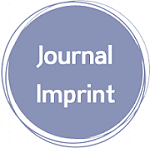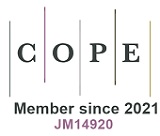Plasma von Willebrand Factor Antigen Levels and Its Relation with ABO Blood Group, Age and Sex
Downloads
Doi:10.28991/SciMedJ-2022-04-02-02
Full Text:PDF
Downloads
Rehman, G. U., Shi, H., Ali, M., & Ali Shah, M. R. (2022). Contemporary global distribution of ABO polymorphism. Human Gene, 33, 201051. doi:10.1016/j.humgen.2022.201051.
O’Donghaile, D., Jenkins, P. V., McGrath, R. T., Preston, L., Field, S. P., Ward, S. E., O’Sullivan, J. M., & O’Donnell, J. S. (2020). Expresser phenotype determines ABO(H) blood group antigen loading on platelets and von Willebrand factor. Scientific Reports, 10(1), 1–11. doi:10.1038/s41598-020-75462-2.
Matsui, T., & Nakamura, Y. (2020). Von Willebrand Factor and ABO Blood Group. Trends in Glycoscience and Glycotechnology, 32(189), E151–E156. doi:10.4052/tigg.1842.1e.
Akpan, I. S., & Essien, E. M. (2016). ABO blood group status and Von Willebrand factor antigen levels in a cohort of 100 blood donors in an African population. International Journal of Biomedical Research, 7(4), 219–222. doi:10.7439/ijbr.v7i4.3147.
Ambika, P. L., Kar, R., Basu, D., & Kulkarni, R. G. (2021). Influence of ABO Blood Group on von Willebrand Factor Antigen Level in Normal Individuals: A Cross-Sectional Study from Southern India. Indian Journal of Hematology and Blood Transfusion, 37(3), 505–506. doi:10.1007/s12288-020-01365-x.
Groeneveld, D. J., van Bekkum, T., Cheung, K. L., Dirven, R. J., Castaman, G., Reitsma, P. H., van Vlijmen, B., & Eikenboom, J. (2015). No evidence for a direct effect of von Willebrand factor’s ABH blood group antigens on von Willebrand factor clearance. Journal of Thrombosis and Haemostasis, 13(4), 592–600. doi:10.1111/jth.12867.
Hernaningsih, Y. (2022). ABO Blood Group and Thromboembolic Diseases. Blood Groups - More than Inheritance of Antigenic Substances. IntechOpen, London, United Kingdom. doi:10.5772/intechopen.102757.
Leebeek, F. W. G., & Eikenboom, J. C. J. (2016). Von Willebrand’s Disease. New England Journal of Medicine, 375(21), 2067–2080. doi:10.1056/nejmra1601561.
Rostami, M., Mansouritorghabeh, H., & Parsa-Kondelaji, M. (2022). High levels of Von Willebrand factor markers in COVID-19: a systematic review and meta-analysis. Clinical and Experimental Medicine, 22(3), 347–357. doi:10.1007/s10238-021-00769-x.
Pablo-Moreno, J. A. D., Serrano, L. J., Revuelta, L., Sánchez, M. J., & Liras, A. (2022). The Vascular Endothelium and Coagulation: Homeostasis, Disease, and Treatment, with a Focus on the Von Willebrand Factor and Factors VIII and V. International Journal of Molecular Sciences, 23(15), 8283. doi:10.3390/ijms23158283.
Rajpal, S., Ahluwalia, J., Kumar, N., Malhotra, P., & Uppal, V. (2019). Elevated Von Willebrand Factor Antigen Levels are an Independent Risk Factor for Venous Thromboembolism: First Report from North India. Indian Journal of Hematology and Blood Transfusion, 35(3), 489–495. doi:10.1007/s12288-019-01092-y.
Soucie, J. M., Miller, C. H., Byams, V. R., Payne, A. B., Abe, K., Sidonio, R. F., & Kouides, P. A. (2021). Occurrence rates of von Willebrand disease among people receiving care in specialized treatment centres in the United States. Haemophilia, 27(3), 445–453. doi:10.1111/hae.14263.
Ward, S. E., O’Sullivan, J. M., & O’Donnell, J. S. (2020). The relationship between ABO blood group, von Willebrand factor, and primary hemostasis. Blood, 136(25), 2864–2874. doi:10.1182/blood.2020005843.
Ng, C., Motto, D. G., & Di Paola, J. (2015). Diagnostic approach to von Willebrand disease. Blood, 125(13), 2029–2037. doi:10.1182/blood-2014-08-528398.
Jenkins, P. V., & O’Donnell, J. S. (2006). ABO blood group determines plasma von Willebrand factor levels: A biologic function after all? Transfusion, 46(10), 1836–1844. doi:10.1111/j.1537-2995.2006.00975.x.
Akpan, I. S., & Asuquo, I. E. (2022). Assessing the Relationship between Plasma Von Willebrand Factor Antigen Levels, ABO and Rh (D) Blood Groups and Risk of Sickle Cell Anaemia Vaso – Occlusive Crisis. Saudi Journal of Medicine, 7(8), 428–434. doi:10.36348/sjm.2022.v07i08.006.
James, P. D., Connell, N. T., Ameer, B., Di Paola, J., Eikenboom, J., Giraud, N., Haberichter, S., Jacobs-Pratt, V., Konkle, B., McLintock, C., McRae, S., Montgomery, R. R., O’Donnell, J. S., Scappe, N., Sidonio, R., Flood, V. H., Husainat, N., Kalot, M. A., & Mustafa, R. A. (2021). ASH ISTH NHF WFH 2021 guidelines on the diagnosis of von Willebrand disease. Blood Advances, 5(1), 280–300. doi:10.1182/BLOODADVANCES.2020003265.
Mensah, K., Nkansah, C., Appiah, S. K., Barnie, J., Timbilla, D. T., Daud, S., Serwaa, D., Osei-Boakye, F., Derigubah, C. A., & Bani, S. B. (2022). Predictive Values of NLR, PLR and MPV for Pre-Eclampsia in Pregnancy: A Retrospective Cross-Sectional Study in a Teaching Hospital, Ghana. International Journal of Research and Reports in Hematology, 5(2), 264–273.
Nkansah, C., Addai-Mensah, O., Mensah, K., Owusu, M., Ephraim, R. K. D., Adu, P., Osei-Boakye, F., Appiah, S. K., Serwaa, D., Derigubah, C. A., & Debrah, A. Y. (2021). Plasminogen Activator Inhibitor-1 in poorly controlled vs. well controlled Type-2 Diabetes Mellitus patients: A case-control study in a district hospital in Ghana. PLOS ONE, 16(4), e0250090. doi:10.1371/journal.pone.0250090.
Swystun, L. L., & Lillicrap, D. (2018). Genetic regulation of plasma von Willebrand factor levels in health and disease. Journal of Thrombosis and Haemostasis, 16(12), 2375–2390. doi:10.1111/jth.14304.
Alharbi, A., Hassan, S. B., Al-Momen, A. K., Al-Saleh, K., Nasr, R., Kohgear, H., & Owaidah, T. (2018). Influence of ABO blood group on von Willebrand factor tests in healthy Saudi blood donors. Blood Coagulation and Fibrinolysis, 29(2), 211–215. doi:10.1097/MBC.0000000000000709.
Asuquo, J. I., Okafor, I. M., Usanga, E. A., & Idongesit, I. (2014). Von Willebrand factor antigen levels in different ABO blood groups in a Nigerian population. International Journal of Biomedical Laboratory Science, 1, 24-28.
Osei-Boakye, F., Nkansah, C., Appiah, S. K., Derigubah, C. A., Mensah, K., Apandago, A. A., Boateng, V. A., Norsi, O. G., & Kogh-Nuu, D. (2022). Seroprevalence, trends, and risk factors of hepatitis B and C among family replacement blood donors; a 7-year retrospective study at Sunyani Municipal Hospital, Ghana. Journal of Immunoassay and Immunochemistry, 1–14. doi:10.1080/15321819.2023.2168555.
Souto, J. C., Almasy, L., Muñiz-Diaz, E., Soria, J. M., Borrell, M., Bayén, L., Mateo, J., Madoz, P., Stone, W., Blangero, J., & Fontcuberta, J. (2000). Functional effects of the ABO locus polymorphism on plasma levels of von Willebrand factor, factor VIII, and activated partial thromboplastin time. Arteriosclerosis, Thrombosis, and Vascular Biology, 20(8), 2024–2028. doi:10.1161/01.ATV.20.8.2024.
Nkansah, C., Serwaa, D., Osei-Boakye, F., & Owusu-Ampomah, R. (2022). Magnitude and trend of HIV and Treponema pallidum infections among blood donors in Offinso-North District, Ghana: a nine-year retrospective, cross-sectional study. African Health Sciences, 22(1), 465–474. doi:10.4314/ahs.v22i1.55.
Owaidah, T., Alharbi, M., Mandourah, M., Saleh, M., Almusa, A., Alnounou, R., Alzahrani, H., & Khogeer, H. (2022). Clinical and laboratory presentation of von Willebrand disease: Experience from a single center in Saudi Arabia. Journal of Taibah University Medical Sciences. doi:10.1016/j.jtumed.2022.10.019.
Van Loon, J., Dehghan, A., Weihong, T., Trompet, S., McArdle, W. L., Asselbergs, F. W., Chen, M. H., Lopez, L. M., Huffman, J. E., Leebeek, F. W. G., Basu, S., Stott, D. J., Rumley, A., Gansevoort, R. T., Davies, G., Wilson, J. J. F., Witteman, J. C. M., Cao, X., De Craen, A. J. M., … O’Donnell, C. (2016). Genome-wide association studies identify genetic loci for low von Willebrand factor levels. European Journal of Human Genetics, 24(7), 1035–1040. doi:10.1038/ejhg.2015.222.
Al-Awadhi, A. M., Al-Sharrah, S. K., Jadaon, M. M., & Al-Sayegh, F. (2014). Investigating the influence of age, gender and ABO blood group on ADAMTS-13 antigen and activity levels in healthy Arabs. Blood Transfusion, 12(1), 138. doi:10.2450/2013.0155-13.
Ladikou, E. E., Sivaloganathan, H., Milne, K. M., Arter, W. E., Ramasamy, R., Saad, R., Stoneham, S. M., Philips, B., Eziefula, A. C., & Chevassut, T. (2020). Von Willebrand factor (vWF): marker of endothelial damage and thrombotic risk in COVID-19 Clinical Medicine, 20(5), e178–e182. doi:10.7861/clinmed.2020-0346.
Alavi, P., Rathod, A. M., & Jahroudi, N. (2021). Age-associated increase in thrombogenicity and its correlation with von willebrand factor. Journal of Clinical Medicine, 10(18), 4190. doi:10.3390/jcm10184190.
Biguzzi, E., Siboni, S. M., le Cessie, S., Baronciani, L., Rosendaal, F. R., van Hylckama Vlieg, A., & Peyvandi, F. (2021). Increasing levels of von Willebrand factor and factor VIII with age in patients affected by von Willebrand disease. Journal of Thrombosis and Haemostasis, 19(1), 96–106. doi:10.1111/jth.15116.
Ajayi, O., Ekakitie, O., & Okpalaugo, O. (2015). Differential Rheology among ABO Blood Group System in Nigerians. Journal of African Association of Physiological Sciences, 3(1), 30–35. doi:10.13140/RG.2.2.20920.60160.
Benedict, N., Augustina, A. O., & Nosakhare, B. G. (2012). Blood Donation in Nigeria: Standard of the Donated Blood. Journal of Laboratory Physicians, 4(02), 094–097. doi:10.4103/0974-2727.105589.
- This work (including HTML and PDF Files) is licensed under a Creative Commons Attribution 4.0 International License.












